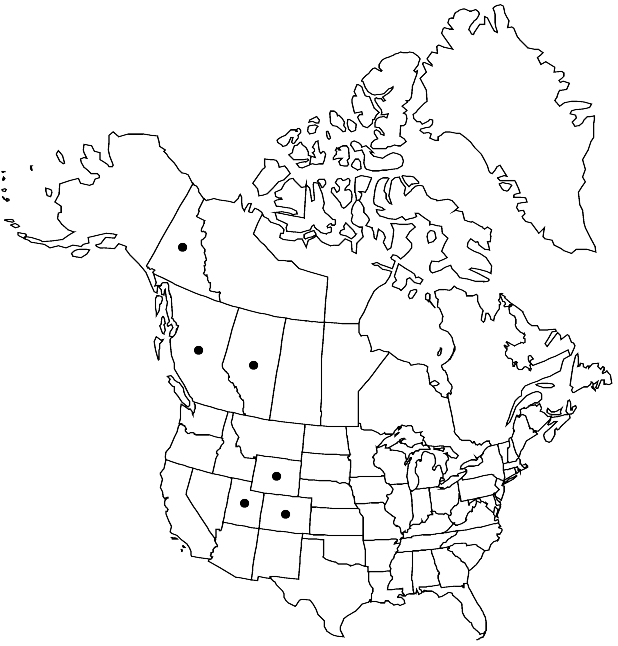Draba ventosa
Amer. Naturalist 8: 212. 1874.
Perennials; (cespitose); caudex branched (covered with persistent leaves, branches creeping, sometimes terminating in sterile rosettes); scapose. Stems unbranched, (0.1–)0.2–0.4(–0.6) dm, densely pubescent throughout, trichomes 2–6-rayed, 0.1–0.6 mm. Basal leaves (imbricate); rosulate; subsessile; petiole base and margin not ciliate; blade obovate to oblanceolate, (0.4–)0.5–1 cm × 1.5–4.5 mm, margins entire, surfaces densely pubescent with stalked, 2–6-rayed trichomes, (0.1–)0.2–0.9 mm. Cauline leaves 0. Racemes 5–10(–16)-flowered, ebracteate, slightly elongated in fruit; rachis not flexuous, densely pubescent as stem. Fruiting pedicels horizontal to divaricate-ascending, straight or slightly curved upward, 2–7(–9) mm, densely pubescent, trichomes 2–6-rayed, (0.1–0.6 mm). Flowers: sepals broadly ovate, 2–2.5 mm, pubescent, (trichomes short-stalked, 2–6-rayed); petals yellow, obovate, 3.5–5.5 × 1.5–3 mm; anthers oblong, 0.5–0.6 mm. Fruits suborbicular to broadly ovate, plane, inflated basally, flattened distally, 4–7.5(–9) × 3.5–5 mm; valves densely pubescent, trichomes short-stalked, 2–6-rayed, 0.15–0.5 mm; ovules 8–12 per ovary; style (0.5–)0.7–1.4 mm. Seeds oblong, 1.4–1.9 × 0.9–1.2 mm. 2n = 36.
Phenology: Flowering Jul–Aug.
Habitat: Talus slopes and alpine tundra
Elevation: 2000-4000 m
Distribution

Alta., B.C., Yukon, Colo., Utah, Wyo.
Discussion
G. A. Mulligan (1971b) first reported apomixis in Draba ventosa based on studies of Canadian populations. This has now been confirmed in one of the southernmost populations (Duchesne County, Utah; M. D. Windham, unpubl.) as well. The species is easily overlooked and the large geographic gap between the Canadian and United States populations is likely to be narrowed or eliminated by additional collecting in western Montana. The limits of this species were expanded by C. L. Hitchcock (1941) to include D. ruaxes, but there are clear differences between them that support their recognition as distinct species.
Selected References
None.